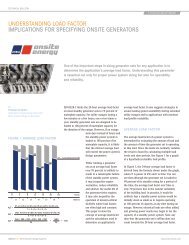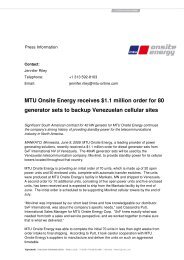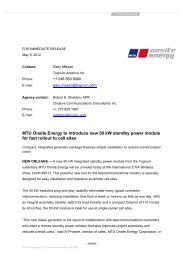Create successful ePaper yourself
Turn your PDF publications into a flip-book with our unique Google optimized e-Paper software.
<strong>MTU</strong> <strong>Onsite</strong> <strong>Energy</strong> electricity generators supply emergency, control and peak-load power<br />
Morning delivery<br />
The future of energy generation is localized<br />
and renewable. But that also changes the<br />
demands placed on the power grids. They<br />
will increasingly have to cope with larger,<br />
fluctuating amounts of energy from wind<br />
farms and solar arrays without allowing the<br />
grid voltage or frequency to drop out. To do<br />
so, they need flexible energy sources that the<br />
grid operators can call upon at short notice.<br />
The energy supplier ÜWAG in Fulda operates<br />
such an energy source. In recent years it has<br />
upgraded its power plant with custom-built<br />
diesel generators from <strong>MTU</strong> <strong>Onsite</strong> <strong>Energy</strong><br />
and now supplies flexible emergency, control<br />
and peak-load power on the dot.<br />
What does Hans Müller in Germany do at 7 in the<br />
morning? He makes a cup of coffee. Luigi Motta<br />
in Italy uses a fan heater to warm up the kitchen.<br />
Michelle Potier in France cooks breakfest. They<br />
all enjoy the last few moments of calm before the<br />
sun rises. Silence reigns but the grid is starting to<br />
hum. Because right on the dot of 7 a.m., not only<br />
Hans Müller, Luigi Motta and Michelle Portier use<br />
electricity – millions of other people do too. The<br />
electricity being generated just at this moment by<br />
power plants both big and small is not enough to<br />
cover the demand. The grid is overloaded.<br />
Combined European grid delivers<br />
This is the moment for flexible power plants.<br />
Überlandwerk Fulda Aktiengesellschaft (ÜWAG<br />
for short) is one of them. It was built 100 years<br />
ago – originally to supply electricity to the citizens<br />
of Fulda. But nowadays there is a combined<br />
European power grid into which not only largescale<br />
power stations but an increasing number<br />
of smaller, localized energy plants feed their<br />
electricity. That power is distributed to the<br />
individual households and industrial facilities via a<br />
network of transformer stations and substations.<br />
ÜWAG in Fulda had to find itself a new place in<br />
that system – and succeeded in doing so.<br />
Power for demand peaks<br />
The plant supplies peak-load power when demand<br />
is so high that there is not sufficient capacity<br />
available in the combined grid. Just about the time<br />
when Hans Müller, Luigi Motta, Michelle Portier<br />
and millions of others switch on the lights or put<br />
on the kettle. “Between 7 and 8 in the morning<br />
and at about 8 in the evening demand for power<br />
rockets,” explained Frank Weinmann, head of the<br />
<strong>Energy</strong> Generation and Procurement department<br />
at ÜWAG. In the past, the demand peak occurred<br />
around midday, whereas now people use most<br />
electricity in the morning when they get up and<br />
when they get home in the evening. “The demand<br />
pattern gives you a good idea of how people’s<br />
lifestyles have changed,” he smiled.<br />
To be able to balance out the demand peaks more<br />
effectively in future, ÜWAG in Fulda has spent<br />
€10 million modernizing its power plant in recent<br />
years. Two old diesel engines were retired and<br />
replaced by six smaller generator sets supplied<br />
by <strong>MTU</strong> <strong>Onsite</strong> <strong>Energy</strong>. The key component of<br />
each genset is a 20-cylinder <strong>MTU</strong> Series 4000<br />
engine. “I don’t know of any diesel power station<br />
in the world that is more modern than ours right<br />
now,” said Frank Weinmann looking down proudly<br />
from the control room onto the blue <strong>MTU</strong> <strong>Onsite</strong><br />
<strong>Energy</strong> power modules. “Those engines are real<br />
Ferraris,” he enthused. They can start up and<br />
synchronize with the European power grid within<br />
a matter of a few seconds. The old engines would<br />
have needed several minutes to do so.<br />
Control power balances out grid fluctuations<br />
“In today’s power generation world you have to be<br />
fast,” he explained and he went on to point out<br />
that it is not just because demand peaks occur<br />
much more frequently nowadays. The constantly<br />
growing proportion of electricity from renewable<br />
sources is also a factor because, in contrast<br />
with conventional large-scale power plants, it<br />
is not possible to precisely predict how reliably<br />
they will supply energy to the grid. Put simply,<br />
When ÜWAG Fulda was built 100 years ago it was<br />
on the edge of the town. But the city has grown since<br />
then and now it is right in the middle of the urban<br />
area.<br />
Frank Weinmann is a qualified engineer and heads<br />
the <strong>Energy</strong> Generation and Procurement department.















![Full power range of diesel generator sets [PDF] - MTU Onsite Energy](https://img.yumpu.com/28297693/1/190x253/full-power-range-of-diesel-generator-sets-pdf-mtu-onsite-energy.jpg?quality=85)
